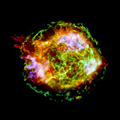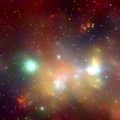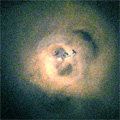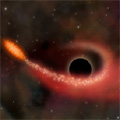An overview of the Chandra mission and goals, Chandra's namesake, top 10 facts.
Classroom activities, printable materials, interactive games & more.
Overview of X-ray Astronomy and X-ray sources: black holes to galaxy clusters.
All Chandra images released to the public listed by date & by category
Current Chandra press releases, status reports, interviews & biographies.
A collection of multimedia, illustrations & animations, a glossary, FAQ & more.
A collection of illustrations, animations and video.
Chandra discoveries in an audio/video format.
Highlights of 5 Years of Chandra Observations
August 23, 2004 ::
X-ray images of the Universe are strikingly different from optical images. The familiar, serene appearance of stars and galaxies is replaced in X-ray images by scorching hot material around supermassive black holes, for example, or by vast regions of ten-million-degree gas. Celestial objects ranging from the cosmically small to the utterly enormous can emit X-rays. Here is a sampling of the wide range of highlights that NASA's Chandra X-ray Observatory has produced during its first five years of science.
Perhaps Chandra's biggest legacy over the past five years has been its contributions to the understanding of black holes - both near and far. With its unique properties, Chandra is peerless as a black hole probe.
 |
|
|
Celebrating 5 Years with Chandra
From "First Light" to its fifth anniversary, Chandra has been exploring the X-ray universe. Celebrate its successes with us: Special edition web features. |
|
 |
Chandra cannot see into a black hole, but it has tackled many of
their other mysteries. It estimated
how many black holes are in the Universe. It studied their
dining habits and
how fast they spin.
It found a black hole that generated the
deepest note ever detected in the Universe, and saw evidence for a star that was torn apart by a supermassive black hole. It observed, for the first time,
two supermassive black holes in the same galaxy, galactic monsters that are destined for a dramatic collision. It found the best evidence for a class of "missing link" black holes with masses lying between those of stellar remnants and
supermassive black holes, and strongly confirmed the reality of the
event horizon.
Chandra has also revealed new information about phenomena throughout our Universe, including those close to home with studies about the origins of the Sun and the solar system. It has studied stellar nurseries like the
Orion Nebula and has given astronomers a new tool for determining if a young star is surrounded by a
planet-forming disk. Within our own solar system, Chandra discovered X-rays from magnetic storms on
Jupiter, and measured the extent of the atmosphere of
Titan, using a rare transit in front of the Crab Nebula. It has also performed remote prospecting on
the Moon.
Supernova explosions are caused by the death of stars more massive than the Sun, and are notably photogenic when viewed in X-rays. A spectacular example is Chandra's new 1-million-second image of the supernova remnant known as
Cassiopeia A. A return to Chandra's "First Light" image from five years ago, this image displays the clarity of Chandra's
X-ray vision. The beautiful structure in the Cassiopeia A image will be studied by astronomers for many years, as the deepest example of many
supernova remnant images obtained by Chandra over the last five years.
Within our own galaxy, Chandra made a spectacular panoramic image of hot gas and accreting binaries in the plane of
the Milky Way. On a smaller scale, Chandra made dramatic movies of the
Crab and
Vela pulsars, cosmic generators of immense power that propel matter to over half the speed of light. The voltages in Vela are a hundred million times that of a lightning bolt. With Chandra, astronomers have used the Universe as a laboratory to used to test physics under
extreme conditions not available on Earth.
By observing colliding galaxies, Chandra can help study the future of the Milky Way. If our galaxy collides with the Andromeda Galaxy in a few billion years, as scientists predict, violent bursts of star formation should result, with supernovas pumping out large amounts of heavy elements. This planet and life-seeding process was vividly captured in a Chandra image of a nearby
galactic collision by Chandra. When a large elliptical galaxy eventually forms, long trails of X-ray sources may be the best evidence for the galaxy's
violent past.
On an even larger scale, Chandra has produced some of its best results on galaxy clusters, the largest bound objects in the Universe. Galaxy-size cavities and streamers in hot gas have been used to trace the history of
black hole outbursts, or study a galaxy
being eviscerated as it plunges through a cluster. Chandra has looked back in time to see a
cluster under construction and has mapped the distribution of
dark matter in clusters. Earlier this year, it found direct evidence for
dark energy and the accelerated expansion of the Universe. The Chandra study confirms results obtained using supernovas and suggests that the expansion of the Universe will continue forever, so that eventually only a tiny fraction of the Universe would be observable. This lonely future, if true, is tens of billions of years away.
This is only a brief selection of Chandra results. Chandra is still young, at less than half the age of its Great Observatory cousin, the Hubble Space Telescope. With extension of the Chandra mission for another 5 years, many exciting observations remain to be made.









